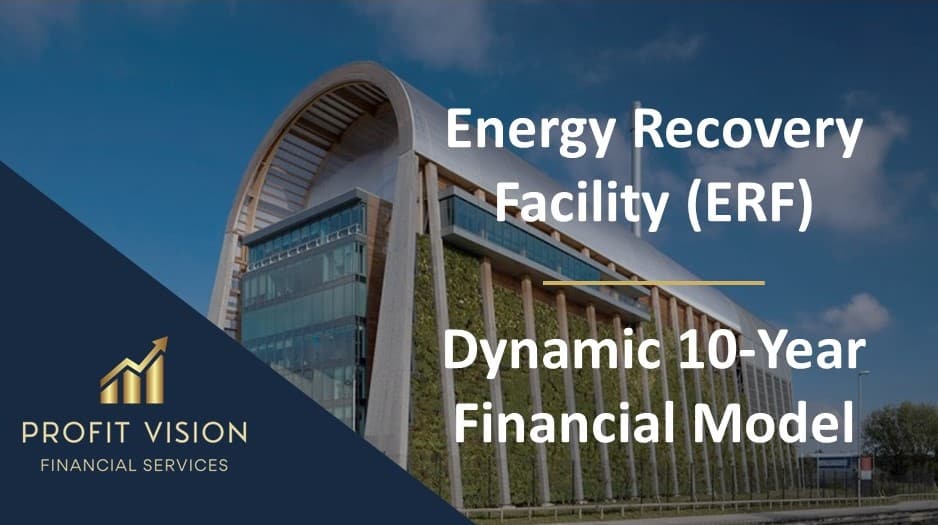EV Battery Recycling Plant Financial Model (10+ Yrs DCF and Valuation)
The EV Battery Recycling Plant financial model is a comprehensive tool designed to analyze the financial aspects of recycling electric vehicle batteries. It encompasses key components such as revenue streams, material recovery rates and financial projections. This model provides insights into the financial performance of the recycling plant, enabling informed decision-making, budgeting, sustainability assessment, and growth planning.

The EV Battery Recycling Plant financial model is a comprehensive tool designed to analyze the financial aspects of recycling electric vehicle batteries. It encompasses key components such as revenue streams, material recovery rates and financial projections. This model provides insights into the financial performance of the recycling plant, enabling informed decision-making, budgeting, sustainability assessment, and growth planning.
Key Components:
- Revenue Streams: The model assesses revenue sources from recycling processes, including recovered materials sales and disposal fees.
- Recycling Costs: It includes costs for collection, transportation, processing, and recycling of EV batteries, as well as operational expenses, labor, and regulatory compliance costs.
- Material Recovery Rates: The model estimates the rate at which valuable materials like lithium, cobalt, and nickel can be recovered from the batteries, influencing revenue and profitability.
Key Benefits:
- Informed Decision Making: The EV Battery Recycling Plant financial model empowers stakeholders to make data-driven decisions regarding recycling processes, pricing strategies, material recovery methods, and resource allocation.
- Budgeting and Cost Control: By providing a comprehensive overview of expenses and potential revenues, the model assists in budgeting and cost control measures, ensuring financial sustainability.
- Sustainability Assessment: The financial model helps evaluate the environmental and economic sustainability of battery recycling, supporting responsible business practices.
- Growth Planning: Financial projections generated by the model support growth planning, allowing plant operators to assess the potential outcomes of expanding recycling capacity, improving efficiency, or entering new markets.
In summary, the EV Battery Recycling Plant financial model offers valuable insights into the financial performance and sustainability of a battery recycling facility. It supports informed decision-making, budgeting, sustainability assessment, and growth planning, all of which contribute to the success and environmental impact of the recycling plant.
——————————————————————————————————————–
MODEL GUIDELINES
So, a quick overview of the model, in the contents tab you can see the structure of the model and by clicking on any of the headlines to be redirected to the relevant worksheet.
On the manual tab you can feed the general information for the model such as: project name & title, responsible, timeline of the model and date and currency conventions.
Additionally, there is a description of the color coding of the model in the same tab. Inputs are always depicted with a yellow fill and blue letters, call up (that is direct links from other cells) are filled in light blue with blue letters while calculations are depicted with white fill and black characters.
There is also color coding for the various tabs of the model. Yellow tabs are mostly assumptions tabs, grey tabs are calculations tabs, blue tabs are outputs tabs (that is effectively results or graphs) and finally light blue tabs are admin tabs (for example: the cover page, contents, and checks).
Moving on to the Inputs: detailed inputs for revenues such as sales split, pricing, and losses costs splits between direct costs (direct labor costs, recycling processing costs) and indirect costs (such as admin staff, outsourced staff, insurance, safety & compliance as well as other costs), working capital (receivables, payables, and inventory), fixed assets and capex (split into initial investment and new maintenance capex), debt & equity financing as well as valuation assumptions (such as discount rates used in the weighted average cost of capital).
In the summary tab you can see a high-level report with the main metrics and value drivers of the model. It can be readily printed on one page for your convenience.
Calculations: this is where all calculations are performed. The revenues are calculated based on the events and price per head per event offered and deducting the operating costs adjusted for inflation the operating profit is resulting. Based on the assets financed and the gearing of the financing the interest and depreciation are occurring. By using the working capital assumptions, the impact of the business cycle is presented. Finally, depending on the level of the investment considered the relevant debt financing is calculated (Long term debt and overdraft).
In the Outputs tab: everything is aggregated here into the relevant statements: profit and loss, balance sheet and cash flow.
Moving to the Valuation tab, a valuation is performed by using the free cash flows to the firm and then a series of investment metrics are presented (Net Present Value, Internal Rate of Return, Profitability Index, Payback Period, Discounted Payback Period, Sensitivity Analysis).
In the Graphs tab: Various graphs present the business metrics, revenues, operating costs, and profitability. Then multiple charts present the working capital, debt & equity along with cash, assets, and cash flows which results in a valuation on a project basis as well as on an equity basis together with the feasibility metrics.
In the Break-Even tab, you can find a break-even analysis and see how many sales you need to break even.
Checks: A dedicated worksheet that makes sure that everything is working as it should!
Important Notice: Yellow indicates inputs and assumptions that the user can change, blue cells are used for called up cells, and white cells with black characters indicates calculation cells.
Similar Products
Other customers were also interested in...
Energy Recovery Facility (ERF) – Dynamic 10 Year...
Financial model presenting a business scenario of a company owning and/or leasing Energy Recover Fac... Read more
Hydrogen Gas Equipment Manufacturing and Sales Mod...
This is a very detailed and user-friendly financial model with three financial statements ... Read more
Ethanol and Sugar Production Plant Financial Model
Fin-wiser’s Ethanol and Sugar Plant PPP project model helps users to assess the financial viabilit... Read more
Hydrogen Gas Sales & Tolling Business Plan an...
Hydrogen Gas Sales & Tolling Fee business plan and valuation model is an excellent tool to asses... Read more
Business Plan for a Biodiesel Manufacturing Plant
Setting up a biodiesel manufacturing plant requires a comprehensive and executed business strategy. ... Read more
Solar Energy Power Plant Financial Model
In order to assess the financial viability of a Solar Park project, the Solar Energy Financial Model... Read more
Solar Panel Manufacturing Plant Business Plan Fina...
Get the Best Solar Panel Manufacturing Plant Financial Model. Spend less time on Cash Flow forecasti... Read more
Manufacturing Startup/Existing Business Financial ...
3 statement 5 year rolling financial projection Excel model for a startup /existing manufacturing bu... Read more
Waste Management Company – Dynamic 10 Year Finan...
Financial model presenting a business scenario of a Waste Management Company collecting Solid Waste ... Read more
Recycling Company Financial Model – Dynamic 10 Y...
Recycling is the process of converting waste materials into new materials and objects. The recovery ... Read more
You must log in to submit a review.




























